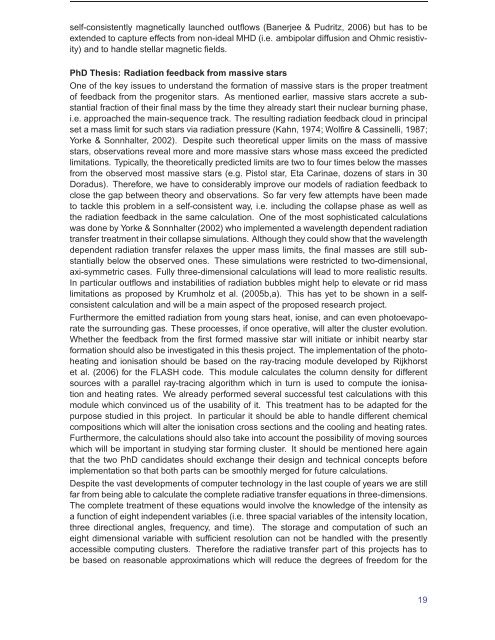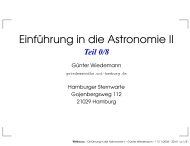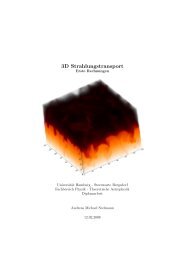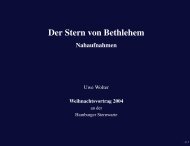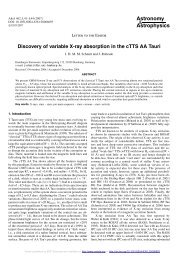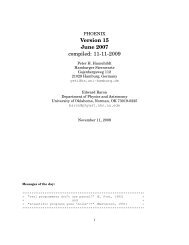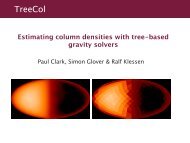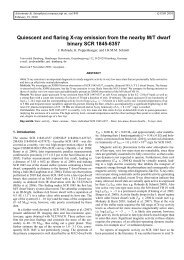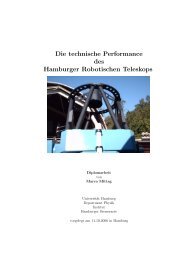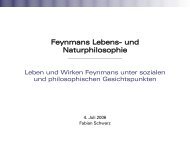Emmy Noether Application
Emmy Noether Application
Emmy Noether Application
Create successful ePaper yourself
Turn your PDF publications into a flip-book with our unique Google optimized e-Paper software.
self-consistently magnetically launched outflows (Banerjee & Pudritz, 2006) but has to be<br />
extended to capture effects from non-ideal MHD (i.e. ambipolar diffusion and Ohmic resistivity)<br />
and to handle stellar magnetic fields.<br />
PhD Thesis: Radiation feedback from massive stars<br />
One of the key issues to understand the formation of massive stars is the proper treatment<br />
of feedback from the progenitor stars. As mentioned earlier, massive stars accrete a substantial<br />
fraction of their final mass by the time they already start their nuclear burning phase,<br />
i.e. approached the main-sequence track. The resulting radiation feedback cloud in principal<br />
set a mass limit for such stars via radiation pressure (Kahn, 1974; Wolfire & Cassinelli, 1987;<br />
Yorke & Sonnhalter, 2002). Despite such theoretical upper limits on the mass of massive<br />
stars, observations reveal more and more massive stars whose mass exceed the predicted<br />
limitations. Typically, the theoretically predicted limits are two to four times below the masses<br />
from the observed most massive stars (e.g. Pistol star, Eta Carinae, dozens of stars in 30<br />
Doradus). Therefore, we have to considerably improve our models of radiation feedback to<br />
close the gap between theory and observations. So far very few attempts have been made<br />
to tackle this problem in a self-consistent way, i.e. including the collapse phase as well as<br />
the radiation feedback in the same calculation. One of the most sophisticated calculations<br />
was done by Yorke & Sonnhalter (2002) who implemented a wavelength dependent radiation<br />
transfer treatment in their collapse simulations. Although they could show that the wavelength<br />
dependent radiation transfer relaxes the upper mass limits, the final masses are still substantially<br />
below the observed ones. These simulations were restricted to two-dimensional,<br />
axi-symmetric cases. Fully three-dimensional calculations will lead to more realistic results.<br />
In particular outflows and instabilities of radiation bubbles might help to elevate or rid mass<br />
limitations as proposed by Krumholz et al. (2005b,a). This has yet to be shown in a selfconsistent<br />
calculation and will be a main aspect of the proposed research project.<br />
Furthermore the emitted radiation from young stars heat, ionise, and can even photoevaporate<br />
the surrounding gas. These processes, if once operative, will alter the cluster evolution.<br />
Whether the feedback from the first formed massive star will initiate or inhibit nearby star<br />
formation should also be investigated in this thesis project. The implementation of the photoheating<br />
and ionisation should be based on the ray-tracing module developed by Rijkhorst<br />
et al. (2006) for the FLASH code. This module calculates the column density for different<br />
sources with a parallel ray-tracing algorithm which in turn is used to compute the ionisation<br />
and heating rates. We already performed several successful test calculations with this<br />
module which convinced us of the usability of it. This treatment has to be adapted for the<br />
purpose studied in this project. In particular it should be able to handle different chemical<br />
compositions which will alter the ionisation cross sections and the cooling and heating rates.<br />
Furthermore, the calculations should also take into account the possibility of moving sources<br />
which will be important in studying star forming cluster. It should be mentioned here again<br />
that the two PhD candidates should exchange their design and technical concepts before<br />
implementation so that both parts can be smoothly merged for future calculations.<br />
Despite the vast developments of computer technology in the last couple of years we are still<br />
far from being able to calculate the complete radiative transfer equations in three-dimensions.<br />
The complete treatment of these equations would involve the knowledge of the intensity as<br />
a function of eight independent variables (i.e. three spacial variables of the intensity location,<br />
three directional angles, frequency, and time). The storage and computation of such an<br />
eight dimensional variable with sufficient resolution can not be handled with the presently<br />
accessible computing clusters. Therefore the radiative transfer part of this projects has to<br />
be based on reasonable approximations which will reduce the degrees of freedom for the<br />
19


